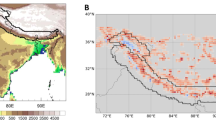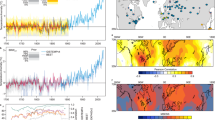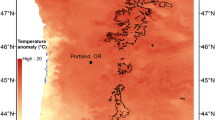Abstract
The high mountains of Asia, including the Karakoram, Himalayas and Tibetan Plateau, combine to form a region of perplexing hydroclimate changes. Glaciers have exhibited mass stability or even expansion in the Karakoram region1,2,3, contrasting with glacial mass loss across the nearby Himalayas and Tibetan Plateau1,4, a pattern that has been termed the Karakoram anomaly. However, the remote location, complex terrain and multi-country fabric of high-mountain Asia have made it difficult to maintain longer-term monitoring systems of the meteorological components that may have influenced glacial change. Here we compare a set of high-resolution climate model simulations from 1861 to 2100 with the latest available observations to focus on the distinct seasonal cycles and resulting climate change signatures of Asia’s high-mountain ranges. We find that the Karakoram seasonal cycle is dominated by non-monsoonal winter precipitation, which uniquely protects it from reductions in annual snowfall under climate warming over the twenty-first century. The simulations show that climate change signals are detectable only with long and continuous records, and at specific elevations. Our findings suggest a meteorological mechanism for regional differences in the glacier response to climate warming.
This is a preview of subscription content, access via your institution
Access options
Subscribe to this journal
Receive 12 print issues and online access
$259.00 per year
only $21.58 per issue
Buy this article
- Purchase on Springer Link
- Instant access to full article PDF
Prices may be subject to local taxes which are calculated during checkout




Similar content being viewed by others
References
Bolch, T. et al. The state and fate of Himalayan glaciers. Science 366, 310–314 (2012).
Hewitt, K. The Karakoram anomaly? Glacier expansion and the ‘elevation effect,’ Karakoram Himalaya. Mt. Res. Dev. 25, 332–340 (2005).
Gardelle, J., Berthier, E. & Arnaud, Y. Slight mass gain of Karakoram glaciers in the early twenty-first century. Nature Geosci. 5, 322–325 (2012).
Kang, S. et al. Review of climate and cryospheric change in the Tibetan Plateau. Environ. Res. Lett. 5, 015101 (2010).
Shrestha, A. B., Wake, C. P., Dibb, J. E. & Mayewski, P. A. Precipitation fluctuations in the Nepal Himalaya and its vicinity and relationship with some large scale climatological parameters. Int. J. Climatol. 20, 317–327 (2000).
Fowler, H. & Archer, D. Conflicting signals of climatic change in the Upper Indus Basin. J. Clim. 19, 4276–4293 (2006).
Bhutiyani, M. R., Vishwas S., Kale & Pawar, N. J. Long-term trends in maximum, minimum and mean annual air temperatures across the Northwestern Himalaya during the twentieth century. Climatic Change 85, 159–177 (2007).
Immerzeel, W. W., Droogers, P., De Jong, S. M. & Bierkens, M. F. P. Large-scale monitoring of snow cover and runoff simulation in Himalayan river basins using remote sensing. Remote Sens. Environ. 113, 40–49 (2009).
Gautam, R., Hsu, N. C., Lau, K. M., Tsay, S. C. & Kafatos, M. Enhanced pre-monsoon warming over the Himalayan-Gangetic region from 1979 to 2007. Geophys. Res. Lett. 36, L07704 (2009).
Treydte, K. et al. The twentieth century was the wettest period in northern Pakistan over the past millennium. Nature 440, 1179–1182 (2006).
Yadav, R. R. et al. Do the western Himalayas defy global warming? Geophys. Res. Lett. 31, L17201 (2004).
Rassmussen, R. et al. How well are we measuring snow: The NOAA/FAA/NCAR winter precipitation test bed. Bull. Am. Meteorol. Soc. 93, 811–829 (2012).
Winiger, M. G. H. Y., Gumpert, M. & Yamout, H. Karakorum–Hindukush–western Himalaya: Assessing high-altitude water resources. Hydrol. Process. 19, 2329–2338 (2005).
Wiltshire, A. J. Climate change implications for the glaciers of the Hindu Kush, Karakoram and Himalayan region. Cryosphere 8, 941–958 (2014).
Palazzi, E., Hardenberg, J. & Provenzale, A. Precipitation in the Hindu-Kush Karakoram Himalaya: Observations and future scenarios. J. Geophys. Res. 118, 85–100 (2013).
Krasting, J., Broccoli, A., Dixon, K. & Lanzante, J. Future changes in northern hemisphere snowfall. J. Clim. 26, 7813–7828 (2013).
Diffenbaugh, N., Scherer, M. & Ashfaq, M. Response of snow-dependent hydrologic extremes to continued global warming. Nature Clim. Change 3, 379–384 (2012).
Akhtar, M., Ahmad, N. & Booij, M. J. The impact of climate change on the water resources of Hindukush–Karakorum–Himalaya region under different glacier coverage scenarios. J. Hydrol. 355, 148–163 (2008).
Delworth, T. et al. Simulated climate and climate change in the GFDL CM2.5 high-resolution coupled climate model. J. Clim. 25, 2755–2781 (2012).
Knutti, R., Masson, D. & Gettelman, A. Climate model genealogy: Generation CMIP5 and how we got there. Geophys. Res. Lett. 40, 1194–1199 (2013).
Kapnick, S. & Delworth, T. Controls of global snow under a changed climate. J. Clim. 26, 5537–5562 (2013).
Meinshausen, M. et al. The RCP greenhouse gas concentrations and their extensions from 1765 to 2300. Climatic Change 109, 213–241 (2011).
Kurita, N. & Hiroyuki, Y. The role of local moisture recycling evaluated using stable isotope data from over the middle of the Tibetan Plateau during the monsoon season. J. Hydrometeorol. 9, 760–775 (2008).
Yatagai, A. et al. APHRODITE: Constructing a long-term daily gridded precipitation dataset for Asia based on a dense network of rain gauges. Bull. Am. Meteorol. Soc. 93, 1401–1415 (2012).
Adler, R. F., Wang, J. J., Gu, G. & Huffman, G. J. A ten-year tropical rainfall climatology based on a composite of TRMM products. J. Meteorol. Soc. Jpn 87A, 281–293 (2009).
Liu, C. & Allan, R. Multisatellite observed responses of precipitation and its extremes to interannual climate variability. J. Geophys. Res. 117, D3 (2012).
Tian, Y. & Peters-Lidard, C. D. A global map of uncertainties in satellite-based precipitation measurements. Geophys. Res. Lett. 37, L24407 (2010).
Andermann, C., Bonnet, S. & Gloaguen, R. Evaluation of precipitation data sets along the Himalayan front. Geochem. Geophys. Geosyst. 12, Q07023 (2011).
Mölg, T., Maussion, F. & Scherer, D. Mid-latitude westerlies as a driver of glacier variability in monsoonal High Asia. Nature Clim. Change 4, 68–73 (2013).
Dimri, A. P. Surface and upper air fields during extreme winter precipitation over the western Himalayas. Pure Appl. Geophys. 163, 1679–1698 (2006).
Immerzeel, W. W., Pellicciotti, F. & Shrestha, A. B. Glaciers as a proxy to quantify the spatial distribution of precipitation in the Hunza basin. M. Res. Dev. 32, 30–38 (2012).
Immerzeel, W. W., van Beek, L. P. & Bierkens, M. F. Climate change will affect the Asian water towers. Science 328, 1382–1385 (2010).
Bookhagen, B. & Burbank, D. W. Toward a complete Himalayan hydrological budget: Spatiotemporal distribution of snowmelt and rainfall and their impact on river discharge. J. Geophys. Res. 115, F03019 (2010).
Kapnick, S. & Hall, A. Causes of recent changes in western North American snowpack. Clim. Dynam. 38, 1885–1899 (2012).
Held, I. M. & Soden, B. J. Robust responses of the hydrological cycle to global warming. J. Clim. 19, 5686–5699 (2006).
Bollasina, M. A., Ming, Y. & Ramaswamy, V. Anthropogenic aerosols and the weakening of the South Asian summer monsoon. Science 334, 502–505 (2011).
Ramanathan, V. et al. Atmospheric brown clouds: Impacts on South Asian climate and hydrological cycle. Proc. Natl Acad. Sci. USA 102, 5326–5333 (2005).
Huffman, G. J. & Bolvin, D. T. TRMM and other data precipitation data set documentation. Laboratory for Atmospheres, NASA Goddard Space Flight Center Report (2014); ftp://precip.gsfc.nasa.gov/pub/trmmdocs/3B42_3B43_doc.pdf
Delworth, T. et al. GFDL’s CM2 global coupled climate models. Part I: Formulation and simulation characteristics. J. Clim. 19, 643–674 (2006).
Acknowledgements
The authors thank the Pakistan Meteorological Department for the observational archives and F. Zeng for running and post-processing data from CM2.5. We acknowledge the World Climate Research Programme’s Working Group on Coupled Modeling, which is responsible for CMIP, and we thank the climate modelling groups for producing and making available their model output. The authors also wish to acknowledge C. Raphael, K. Dunne and E. Mason for help in providing graphical editing of the figures, analysing topography and downloading CMIP5 data. The authors also thank K. Findell and K. Dixon for providing helpful comments and discussions of the manuscript. Any use of trade, product or firm names is only for descriptive purposes and does not imply endorsement by the US Government.
Author information
Authors and Affiliations
Contributions
S.B.K. led the development of this study, carried out all analysis using GCM and observation data and led the writing of the manuscript. M.A. conducted quality control of the station data and carried out analysis using reanalysis data. T.L.D., S.M. and P.C.D.M. contributed to the development of the methodology. All authors contributed to the discussion and writing of the manuscript.
Corresponding author
Ethics declarations
Competing interests
The authors declare no competing financial interests.
Supplementary information
Supplementary Information
Supplementary Information (PDF 4476 kb)
Rights and permissions
About this article
Cite this article
Kapnick, S., Delworth, T., Ashfaq, M. et al. Snowfall less sensitive to warming in Karakoram than in Himalayas due to a unique seasonal cycle. Nature Geosci 7, 834–840 (2014). https://doi.org/10.1038/ngeo2269
Received:
Accepted:
Published:
Issue Date:
DOI: https://doi.org/10.1038/ngeo2269
This article is cited by
-
Runoff modelling and quantification of supraglacial debris impact on seasonal streamflow in the highly glacierized catchments of the western Karakoram in Upper Indus Basin, Pakistan
Environmental Earth Sciences (2024)
-
A cleaner snow future mitigates Northern Hemisphere snowpack loss from warming
Nature Communications (2023)
-
Simulation of the potential impacts of lakes on glacier behavior over the Tibetan Plateau in summer
Climate Dynamics (2023)
-
Assessment of Hydro-climatic Variables and Its Impact on River Flow Regime in the Sub-basins of the Upper Indus Basin
Earth Systems and Environment (2023)
-
Contrasting changes of snowfall in response to temperature and rainfall over two distinct geographic ranges of the Himalayas: A study using the High Asia Refined analysis data
Journal of Earth System Science (2023)



